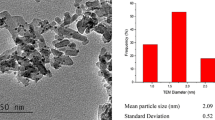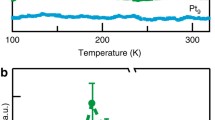Abstract
Monodisperse Pt nanoparticles (NPs) with well-controlled sizes in the range between 1.5 and 10.8 nm, and shapes of octahedron, cube, truncated octahedron and spheres (~6 nm) were synthesized employing the polyol reduction strategy with polyvinylpyrrolidone (PVP) as the capping agent. We characterized the as-synthesized Pt nanoparticles using transmission electron microscopy (TEM), high resolution TEM, sum frequency generation vibrational spectroscopy (SFGVS) using ethylene/H2 reaction as the surface probe, and the catalytic ethylene/H2 reaction by means of measuring surface concentration of Pt. The nanoparticles were supported in mesoporous silica (SBA-15 or MCF-17), and their catalytic reactivity was evaluated for the methylcyclopentane (MCP)/H2 ring opening/ring enlargement reaction using 10 torr MCP and 50 torr H2 at temperatures between 160 and 300 °C. We found a strong correlation between the particle shape and the catalytic activity and product distribution for the MCP/H2 reaction on Pt. At temperatures below 240 °C, 6.3 nm Pt octahedra yielded hexane, 6.2 nm Pt truncated octahedra and 5.2 nm Pt spheres produced 2-methylpentane. In contrast, 6.8 nm Pt cubes led to the formation of cracking products (i.e. C1–C5) under similar conditions. We also detected a weak size dependence of the catalytic activity and selectivity for the MCP/H2 reaction on Pt. 1.5 nm Pt particles produced 2-methylpentane for the whole temperature range studied and the larger Pt NPs produced mainly benzene at temperatures above 240 °C.
Graphical abstract












Similar content being viewed by others
References
Zaera F, Godbey D, Somorjai GA (1986) J Catal 101:73–80
Narayanan R, El-Sayed MA (2004) Nano Lett 4:1343–1348
Kuhn JN, Tsung CK, Huang W, Somorjai GA (2009) J Catal 265:209–215
Tsung CK, Kuhn JN, Huang WY, Aliaga C, Hung LI, Somorjai GA, Yang PD (2009) J Am Chem Soc 131:5816–5822
Kuhn JN, Huang WY, Tsung CK, Zhang YW, Somorjai GA (2008) J Am Chem Soc 130:14026
Kliewer CJ, Aliaga C, Bieri M, Huang WY, Tsung CK, Wood JB, Komvopoulos K, Somorjai GA (2010) J Am Chem Soc 132:13088–13095
Brandenberger SG, Callender WL, Meerbott WK (1976) J Catal 42:282–287
Zhuang YP, Frennet A (1999) Appl Catal A Gen 177:205–217
Galperin LB, Bricker JC, Holmgren JR (2003) Appl Catal A Gen 239:297–304
Bai XL, Sachtler WMH (1991) J Catal 129:121–129
Teschner D, Paal Z, Duprez D (2001) Catal Today 65:185–190
Samoila P, Boutzeloit M, Especel C, Epron F, Marecot P (2009) Appl Catal A Gen 369:104–112
Poupin C, Pirault-Roy L, La Fontaine C, Toth L, Chamam M, Wootsch A, Paal Z (2010) J Catal 272:315–319
Vaarkamp M, Dijkstra P, Vangrondelle J, Miller JT, Modica FS, Koningsberger DC, Vansanten RA (1995) J Catal 151:330–337
Kramer R, Fischbacher M (1989) J Mol Catal 51:247–259
Anderson JBF, Burch R, Cairns JA (1987) J Catal 107:351–363
Glassl H, Hayek K, Kramer R (1981) J Catal 68:397–405
Rioux RM, Song HJ, Yang PD, Somorjai GA (2005) Abstr Pap Am Chem S 229:U723–U723
Fievet F, Lagier JP, Blin B, Beaudoin B, Figlarz M (1989) Solid State Ionics 32–3:198–205
Alayoglu S, Eichhorn B (2008) J Am Chem Soc 130:17479–17486
Horiuti I, Polanyi M (1934) T Faraday Soc 30:1164–1172
Cremer PS, Su XC, Shen YR, Somorjai GA (1996) J Am Chem Soc 118:2942–2949
McCrea KR, Somorjai GA (2000) J Mol Catal A Chem 163:43–53
Watwe RM, Cortright RD, Norskov JK, Dumesic JA (2000) J Phys Chem B 104:2299–2310
Anghel AT, Jenkins SJ, Wales DJ, King DA (2006) J Phys Chem B 110:4147–4156
Sun YG, Xia YN (2002) Science 298:2176–2179
Hayek K, Kramer R, Paal Z (1997) Appl Catal A Gen 162:1–15
Hayek K, Fuchs M, Klotzer B, Reichl W, Rupprechter G (2000) Top Catal 13:55–66
Corolleu C, Juttard D, Muller JM, Gault FG, Maire G (1972) J Catal 27:466
Alvarez WE, Resasco DE (1996) J Catal 164:467–476
Rioux RM, Hsu BB, Grass ME, Song H, Somorjai GA (2008) Catal Lett 126:10–19
Rupprechter G, Freund HJ (2001) Top Catal 14:3–14
Acknowledgments
This work is funded by Office of Science, Department of Energy. The authors acknowledge support of the National Center for Electron Microscopy, Lawrence Berkeley Lab, which is supported by the U.S. Department of Energy under Contract # DE-AC02-05CH11231. Work at the Molecular Foundry was supported by the Director, Office of Science, Office of Basic Energy Sciences, Division of Material Sciences and Engineering, of the U.S. Department of Energy under Contract # DE-AC02-05CH11231.
Author information
Authors and Affiliations
Corresponding author
Electronic supplementary material
Below is the link to the electronic supplementary material.
Rights and permissions
About this article
Cite this article
Alayoglu, S., Aliaga, C., Sprung, C. et al. Size and Shape Dependence on Pt Nanoparticles for the Methylcyclopentane/Hydrogen Ring Opening/Ring Enlargement Reaction. Catal Lett 141, 914–924 (2011). https://doi.org/10.1007/s10562-011-0647-6
Received:
Accepted:
Published:
Issue Date:
DOI: https://doi.org/10.1007/s10562-011-0647-6




